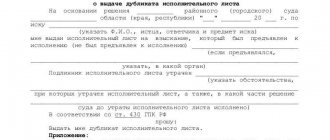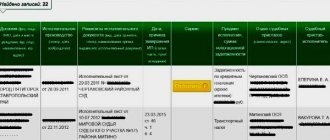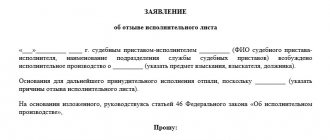Home /Articles on bankruptcy of individuals
Author of the article: Konstantin Milantiev
Last revised September 04, 2021
Reading time 9 minutes
Bailiffs have ample opportunities to ruin the life of a debtor as part of forced collection. Citizens are quite logically interested in whether and how long the statute of limitations for enforcement proceedings exists. This question is probably of interest to the creditor, since delay means the impossibility of subsequent collections. We'll tell you when the collection of old debts stops.
Let's understand the concepts
Strictly speaking, the term “limitation period” is incorrect to apply to a writ of execution and a court order. This is explained simply: the statute of limitations concerns the right of a person to file a claim in court. The legal period for filing a lawsuit is 3 years from the date when a person learned of a violation of his right. For example, when a person stopped paying a loan. The court issues a writ of execution or order when the claim is satisfied, that is, the trial has already been completed.
At the same time, “statute of limitations” is a term that is well understood by everyone. That’s why it is often used even where it is not entirely legal. The main thing is that the participants in the conversation understand what exactly is being discussed.
Statute of limitations for debt collection
Statutes of limitations for various reasons
First, it makes sense to understand how long a writ of execution for debt collection is valid. The answer depends on the type of writ of execution (hereinafter referred to as IL). In accordance with Article 21 No. 229-FZ:
- As a general rule, the creditor has three years to present a writ of execution.
The countdown begins from the moment the court decision enters into force; - IL with an omitted statute of limitations, but restored by a court decision, must be presented for collection within two months;
- IL with regular payments can be presented during the entire period of these payments, to which another three years are added;
- IL for administrative offenses is valid for two years
after the entry into force of the court decision; - The statute of limitations for an IL with a claim for the return of a child who entered the territory of the Russian Federation illegally is one year.
A court order is presented to open enforcement proceedings no later than three years from the date the document enters into force.
Two more special cases deserve special mention:
- a court decision where the debtor is given a period of time for execution,
- the debtor received an installment plan or deferment under the IL.
Then the period for collection under the writ of execution begins from the end of the time for payment or deferment of payments.
When the deadline is interrupted
Article 22 No. 229-FZ provides for two cases of interruption of the three-year validity period of the IL:
- Submitting the sheet for execution to the bailiff or the bank.
- Partial execution by the debtor of a court decision.
After the expiration of the grounds for interruption, the validity period of the writ of execution for the collection of funds continues.
If the IL is returned to the creditor due to impossibility of execution, the statute of limitations is counted anew. That is, if the bailiff returned the sheet or order due to the fact that he did not find the debtor and his property, then the bank will have another 3 years to present the documents again. But No. 229-FZ provides for two exceptions:
- the return occurred at the initiative of the creditor;
- The debtor has taken actions that interfere with the collection of the debt.
In these cases, the period of enforcement proceedings interrupted due to the claimant is deducted from the time for applying to the FSSP (3 years).
If the debtor is declared bankrupt, this means the automatic termination of both the IL and the previously opened enforcement proceedings. This is regulated by the provisions of Article 96 No. 229-FZ (clause 4).
In this case, the enforcement proceedings are suspended, and all related seizures of property and money, bans on traveling abroad and driving a car are lifted from the beginning of the bankruptcy procedure in court. And after the court completes the procedure and writes off the debts, everything is used. Bailiffs are required to close cases. Banks cannot resume collection, even if the person gets a job or receives other income (inheritance, gift).
IP termination procedure?
Actions upon completion of the proceedings are carried out by the bailiff who was involved in its conduct. The procedure for completing production includes:
- issuing a ruling that the proceedings are completed;
- sending the resolution to interested parties (debtor, court, collector, etc.).
The bailiff must send the order to complete the enforcement proceedings immediately. According to the law, this must be done no later than the day following the day of its issuance.
Important! If the debtor has repaid the debt but has not paid the enforcement fee, an employee of the Bailiff Service may initiate enforcement proceedings again. The initiation of an IP for this circumstance is carried out in the same manner as the initial one.
What consequences does the termination of proceedings have for the debtor?
The end of enforcement proceedings means that the debtor will be relieved of all obligations (if the debt is paid to the collector). In addition, upon completion of the proceedings, the Bailiff Service no longer has the right to search for the debtor, his property and money belonging to him. If the debtor was prohibited from traveling abroad, then the end of enforcement proceedings removes this ban.
Let's summarize. The end of enforcement proceedings consists of the bailiff performing a number of actions provided for by law. But, if the requirements contained in the ID have not been met, then the applicant can initiate the collection process again.
At the same time, all parties to the individual entrepreneur (both the collector and the debtor) are recommended to enlist the support of a professional lawyer: this will help avoid mistakes and prevent violation of your rights by interested parties.
Sources:
Federal Law dated October 2, 2007 No. 229-FZ “On Enforcement Proceedings”. Article 47. Termination of enforcement proceedings
Completion and termination of enforcement proceedings
The procedure for restoring a missed deadline for applying to the FSSP
The grounds for restoring the deadline for filing an application with the FSSP are established by Article 23 No. 229-FZ. It contains a list of valid reasons, if documented, the court will extend the period when a claim can be filed. sheet. These include:
- illness of the creditor (confirmed by medical documents);
- lack of information about the possibility of collecting the debt (the situation rarely arises - if the writ of execution has not been sent to the collector);
- long-term business trip (required to provide a travel certificate);
- other circumstances that the judge considers objective.
In practice, these are isolated cases when the claimant is an individual. the person has been ill for several years or is away from home. If the creditor is an organization, bank or microfinance organization, then the terms are not restored.
Deadlines for opening enforcement proceedings
How bailiffs work - law and realityRelated article
Readers ask how long the bailiff's writ of execution is valid, hoping to write off debts within the time frame. If the sheet is presented to the FSSP, then its validity period is unlimited - the bailiff will collect the money until full payment is made, or will end the case if there is no income or property.
In this case, the bank or other creditor can present the IL again in six months or earlier if the debtor has finances or property is discovered.
Duration of enforcement proceedings
The next question is how long does enforcement proceedings last for bailiffs? According to Art. 36 Federal Law No. 229-FZ, the FSSP employee is given two months to execute the court decision.
In practice, cases where debt repayment occurs in such a short time are extremely rare. At the request of the claimant, the bailiff may extend the term, for which he will issue a separate ruling - for example, if no answers have been received from the state. authorities about the debtor's property, if the person is wanted, if an auction is being prepared.
Enforcement proceedings may also be suspended:
- by a court decision - for example, if the debtor challenges the collection on newly discovered grounds or when bankruptcy is declared in the Arbitration Court;
- in the event of the death of the debtor or his recognition as incompetent - until the date of identification of heirs or guardians;
- at the request of the debtor himself - in case of his illness or conscription into the army.
If the bailiff checked the property and income of an individual. person, and came to the conclusion that there is nothing to collect, the IL is returned to the collector. Resumption of enforcement proceedings occurs at any time in accordance with a repeated application by the creditor. As already noted, the basis for its complete termination is the bankruptcy of the debtor.
Enforcement proceedings for dummies. Collection from the debtor organization. Part 1. Introduction.
Collection from a debtor-organization is, of course, a much larger issue than collection from a debtor-citizen.
The variety of organizational and legal forms of legal entities, the peculiarities of maintaining property records (accounting), and the variety of types of property make it impossible to develop instructions “for all occasions.”
Nevertheless, we offer your opinion an algorithm for the direction in which you need to move, as well as useful practical tips.
First of all, if a legal entity conducts financial and economic activities, it is best to present the writ of execution to the bank where the debtor has a current account. Of course, you can present a writ of execution to the bailiff, but there is a high probability of wasting time on various bureaucratic procedures.
In the event that you do not know the debtor’s current accounts, then the claimant, in accordance with clause 8 of Art. 69 of the Law (hereinafter referred to as the Federal Law “On Enforcement Proceedings”), you have the right to request the tax authorities. It is necessary to write a request to the tax authority, attaching a copy of the writ of execution. In accordance with paragraph 10 of Art. 69 of the Law, tax authorities are required to respond within 7 days from the date of receipt of the request.
The claimant may request the following information from the tax authorities (clause 9 of Article 69 of the Law): - on the name and location of banks and other credit organizations in which the debtor’s accounts are opened; - about current account numbers.
At the same time, if the debtor has several current accounts, a question arises. Which bank account should I submit my writ of execution to?
If all the accounts are in the same bank, then there are no special problems; in the application for the presentation of a writ of execution, you don’t even have to indicate the account details; it is enough to indicate the name of the debtor and his address.
If the accounts are in different banks, you will have to act sequentially, presenting a writ of execution to all banks of the debtor.
You might get lucky and get it right. Let me remind you that in case of insufficient funds, the bank will place the writ of execution in the file cabinet of settlement documents not paid on time. If the funds have not been received within 1-2 weeks, it is advisable to revoke the writ of execution from the bank and present it to another bank where the debtor has current accounts.
At the same time, the bailiff has an undeniable advantage over the recoverer - he can submit for collection his orders to foreclose on funds against all accounts at the same time. The issue of foreclosure on funds will be discussed in more detail in the following articles. The claimant has no other powers other than to present his writ of execution to the bank. Now let's look at the question of how a bailiff works in practice with a debtor organization in order to have an idea about this and, if possible, adjust the activities of the bailiff.
Below we will consider an example of recovery from an existing legal entity. Having initiated enforcement proceedings, if the writ of execution is presented for the first time, the bailiff in accordance with paragraph 11 of Art. 30 of the Law sets the debtor a period for voluntary execution, which cannot exceed five days, and which begins to run from the day following the delivery of the decision to initiate enforcement proceedings to the debtor. Let us remind you that time limits in enforcement proceedings are calculated in working days.
That is why it is advisable to assist the bailiff in delivering the decision, for example, by handing it over to the debtor by courier (to the secretariat or personally to the director). In any case, the issue of serving the decision on initiation is very important; at a minimum, it is necessary to ensure that it is sent by registered mail.
The period for voluntary execution is not provided in the following cases (clause 14 of Article 30 of the Law): 1) in accordance with Part 16 of Art. 30 of the Law (here we are talking about a separate collection of enforcement fees and fines from the debtor, this does not concern you); 2) upon subsequent presentation of the writ of execution; 3) about reinstatement at work; 4) on administrative suspension of activities; 5) on confiscation of property.
Upon expiration of the period established for voluntary execution, the bailiff may apply enforcement measures established in Art. 68 Federal Law “On Enforcement Proceedings”. Carry out enforcement actions specified in Art. 64 of the Law, the bailiff has the right even before the expiration of the deadline for voluntary execution.
Here is a list of enforcement actions specified in Art. 64 of the Law (not exhaustive): 1) summon the parties to enforcement proceedings (their representatives), other persons; 2) request the necessary information from individuals, organizations and bodies located on the territory of the Russian Federation, as well as on the territories of foreign states, receive explanations, information, and certificates from them; 3) conduct an inspection, including an inspection of financial documents, regarding the execution of executive documents; 4) give instructions to individuals and legal entities to fulfill the requirements contained in executive documents; 5) enter non-residential premises and storage facilities occupied by the debtor or other persons or belonging to the debtor or other persons for the purpose of executing enforcement documents; 6) with the permission in writing of the senior bailiff (and in the case of execution of a writ of execution on the move-in of the claimant or eviction of the debtor - without the said permission) to enter the residential premises occupied by the debtor without the consent of the debtor; 7) in order to ensure the execution of a writ of execution, seize property, including cash and securities, seize said property, transfer seized and seized property for storage; evaluate property; 9) involve specialists to evaluate property; 10) search for the debtor, his property, search for the child independently or with the involvement of internal affairs bodies; 11) request the necessary information from the parties to enforcement proceedings; 12) consider applications and petitions of the parties to enforcement proceedings and other persons participating in enforcement proceedings; 13) collect enforcement fees and impose fines on the debtor and other persons; 14) contact the body that carries out state registration of rights to property and transactions with it to register the property owned by him in the name of the debtor; 15) establish temporary restrictions on the debtor’s departure from the Russian Federation; 16) check the correctness of the withholding and transfer of funds according to a judicial act, an act of another body or official at the request of the claimant or on one’s own initiative.
64 of the Law (not exhaustive): 1) summon the parties to enforcement proceedings (their representatives), other persons; 2) request the necessary information from individuals, organizations and bodies located on the territory of the Russian Federation, as well as on the territories of foreign states, receive explanations, information, and certificates from them; 3) conduct an inspection, including an inspection of financial documents, regarding the execution of executive documents; 4) give instructions to individuals and legal entities to fulfill the requirements contained in executive documents; 5) enter non-residential premises and storage facilities occupied by the debtor or other persons or belonging to the debtor or other persons for the purpose of executing enforcement documents; 6) with the permission in writing of the senior bailiff (and in the case of execution of a writ of execution on the move-in of the claimant or eviction of the debtor - without the said permission) to enter the residential premises occupied by the debtor without the consent of the debtor; 7) in order to ensure the execution of a writ of execution, seize property, including cash and securities, seize said property, transfer seized and seized property for storage; evaluate property; 9) involve specialists to evaluate property; 10) search for the debtor, his property, search for the child independently or with the involvement of internal affairs bodies; 11) request the necessary information from the parties to enforcement proceedings; 12) consider applications and petitions of the parties to enforcement proceedings and other persons participating in enforcement proceedings; 13) collect enforcement fees and impose fines on the debtor and other persons; 14) contact the body that carries out state registration of rights to property and transactions with it to register the property owned by him in the name of the debtor; 15) establish temporary restrictions on the debtor’s departure from the Russian Federation; 16) check the correctness of the withholding and transfer of funds according to a judicial act, an act of another body or official at the request of the claimant or on one’s own initiative.
The main difference between executive actions and compulsory execution measures is that enforcement actions “promote” the fulfillment of the requirements of the executive document, but compulsory execution measures are directly aimed at its execution.
For example, obtaining information about the debtor’s property is an executive action; by and large, it is neither hot nor cold for the collector. But foreclosure on this property (seizure and sale of the debtor’s property) directly satisfies the claimant’s demands. The list of enforcement measures is also not exhaustive and is contained in Art. 68 of the Law: 1) foreclosure on the debtor’s property, including cash and securities; 2) foreclosure on periodic payments received by the debtor due to labor, civil or social legal relations; 3) foreclosure of the debtor’s property rights, including the right to receive payments in enforcement proceedings in which he acts as a claimant, the right to receive payments for hire, rent, as well as exclusive rights to the results of intellectual activity and means of individualization, rights of claim under agreements on the alienation or use of the exclusive right to the result of intellectual activity and a means of individualization, the right to use the result of intellectual activity or a means of individualization, owned by the debtor as a licensee; 4) confiscation from the debtor of property awarded to the claimant; 5) seizure of the debtor’s property located with the debtor or third parties, in pursuance of a judicial act on the seizure of property; 6) applying to the registration authority to register the transfer of the right to property, including securities, from the debtor to the claimant; 7) performance on behalf and at the expense of the debtor of an action specified in a writ of execution, if this action can be performed without the personal participation of the debtor; forced entry of the claimant into the residential premises; 9) forced eviction of the debtor from the residential premises; 10) release of non-residential premises, storage facilities from the presence of the debtor and his property in them.
But foreclosure on this property (seizure and sale of the debtor’s property) directly satisfies the claimant’s demands. The list of enforcement measures is also not exhaustive and is contained in Art. 68 of the Law: 1) foreclosure on the debtor’s property, including cash and securities; 2) foreclosure on periodic payments received by the debtor due to labor, civil or social legal relations; 3) foreclosure of the debtor’s property rights, including the right to receive payments in enforcement proceedings in which he acts as a claimant, the right to receive payments for hire, rent, as well as exclusive rights to the results of intellectual activity and means of individualization, rights of claim under agreements on the alienation or use of the exclusive right to the result of intellectual activity and a means of individualization, the right to use the result of intellectual activity or a means of individualization, owned by the debtor as a licensee; 4) confiscation from the debtor of property awarded to the claimant; 5) seizure of the debtor’s property located with the debtor or third parties, in pursuance of a judicial act on the seizure of property; 6) applying to the registration authority to register the transfer of the right to property, including securities, from the debtor to the claimant; 7) performance on behalf and at the expense of the debtor of an action specified in a writ of execution, if this action can be performed without the personal participation of the debtor; forced entry of the claimant into the residential premises; 9) forced eviction of the debtor from the residential premises; 10) release of non-residential premises, storage facilities from the presence of the debtor and his property in them.
However, there is another very important difference between executive actions and enforcement measures. Enforcement actions can be of any kind, the most important thing is that they are aimed at facilitating the fulfillment of the requirements of the executive document (clause 17 of Article 64 of the Law).
Compulsory enforcement measures can only be those specified in the federal law or in the text of the enforcement document itself. That is, the bailiff does not have the right to independently “invent” enforcement measures. For example, a bailiff does not have the right to oblige the debtor to sell his property and transfer funds to the deposit of the bailiff department. The Law does not contain such enforcement measures. He has the right to apply such a measure if it is stated verbatim in the judicial act (which is unlikely).
Most often, judicial acts contain instructions to debtors to perform certain actions, for example, move the fence three meters, not interfere with the use of the apartment, etc. Now, since you are fully familiar with the arsenal of the bailiff, let's proceed to direct collection from the debtor.
In accordance with paragraph 3 of Art. 69 of the Law, foreclosure on the debtor’s funds is carried out first (only in case of insufficiency or absence of funds, foreclosure is applied to other property of the debtor - clause 4 of Article 69 of the Law). Violation of this rule may entail the recognition of all subsequent actions of the bailiff as illegal, with all the ensuing consequences (recognition of transactions as invalid, recovery of losses from the treasury of the Russian Federation). Judicial practice confirming this statement is easy to find in the legal reference system.
So, for example, in its resolution in the case NА33-11212/03-С6-ФО2-2021/04-С2 dated June 8, 2004, the FAS of the East Siberian District declared the actions of the bailiff illegal, due to the fact that the bailiff - the executor seized the property of the third stage without checking the existence of the first and second stages of foreclosure.
In particular, the court stated the following: “…..Article 59 of the Federal Law “On Enforcement Proceedings”1 provides that, first of all, the seizure of the property of a debtor organization is imposed on property not directly involved in the proceedings (securities, funds on deposit and other debtor's accounts, currency values, passenger vehicles, office design items, etc.).
Thus, these provisions of the law provide for the duty of the bailiff to first of all foreclose on the debtor’s funds, for which it is necessary to check the presence or absence of funds in the cash register and on the debtor’s current current accounts. The Arbitration Court of the Krasnoyarsk Territory rightfully recognized that in the absence of the specified actions to identify the property of the debtor of the first stage, the bailiff had no grounds for arresting the property of the debtor, classified by law as the third stage......"
Despite the fact that the resolution is dated 2004, it is still relevant today. Due to the fact that the issue of foreclosure on the debtor’s funds is voluminous, we will separate its consideration into separate articles, dividing it into two parts: foreclosure on cash and non-cash funds.
1. Federal Law “On Enforcement Proceedings” No. 119-FZ dated July 21, 1997
Unlock access to the private part of Clerk with a Premium subscription. Get hundreds of webinars and online courses, unlimited consultations and other proprietary content for accountants.
Hurry up to subscribe with a 20% discount until October 15, 2021. Read more about “Premium” here.
Deadline for payment of court debt
The debtor is given 5 working days to voluntarily comply with the court decision. In this case, the enforcement fee is not charged - 7% of the debt amount, but not less than 1000 rubles.
The period is counted from the date when the debtor received a copy of the resolution on the commencement of enforcement proceedings in any way:
- in the hands
of the bailiff; - by mail
is the most common method. A copy of the document is sent to the debtor's address. Moreover, if the debtor does not receive the letter due to his own fault - he refuses to deliver it at the post office, then he will still be considered notified; - through State Services.
Yes, in 2021 the bailiff has the right to notify the debtor about the initiation of a case on the State Services portal, and such online information is considered appropriate and completely legal.
If within the next 5 business days the money is not sent to the FSSP account, the debtor will have to pay a fee for the service. Moreover, if the person subsequently pays on his own or agrees with the creditor on a repayment schedule, the fee will still be collected.
You can check the debt with the bailiffs by last name on the official website or through our verification service. Both are free.
Signs of renewed production
Society believes that the time period for debt is officially interrupted after a call from bank employees. This is mistake. According to the law, it is considered officially interrupted if:
- The borrower acknowledged his debt to the institution.
- If, within the prescribed period, the organization files a lawsuit.
- The debtor visits the plaintiff and signs any document related to the loan agreement.
- The man repaid even the meager amount of the overdue loan.
In order to officially renew the limitation period, employees of financial organizations invite the debtor to their place under any pretext. Here he may be required to sign something or pay a certain amount on the bill.
Performing such manipulations automatically renews the limitation period for the claim. This also includes any official communication between the participants in the proceedings. The following factors will not affect the calculation of time:
- The debtor receives SMS or receives a call on his mobile;
- A conversation took place between the borrower and the creditor. It does not matter here whether the conversation was recorded or not;
- The conversation was recorded, but during its implementation the existence of a debt was not recognized. Here it will be very difficult to prove that the conversation took place with the borrower.
The limitation period is relevant for all types of credit, for a car loan and for a mortgage. The situation is completely different with secured loans. There is always something to pick up here, so there is no reason to wait three years.
How quickly do bailiffs close proceedings?
Termination of recovery in enforcement proceedingsRelated article
The inability of the debtor to fulfill financial obligations established by a court decision becomes the basis for termination or termination of proceedings. The bailiff makes such a decision within a period of two months to three years after opening. The writ of execution is returned to the claimant.
After the bailiff completed the case under Part 4, Clause 1 of Art. 46 Federal Law No. 229, a citizen has the right to submit documents to the MFC to write off debts of up to half a million in out-of-court bankruptcy.
At the same time, in the list of creditors you can indicate not only the debt that the bailiffs had, but also other arrears - outstanding loans and microloans, housing and communal services, taxes and fines, even debt for the Internet or telephone.
How to prepare documents for free bankruptcy through the MFC, how much they will write off, and what you can do during the procedure, we described in a special material.
Until the citizen has written off the debts through the MFC, the creditor has the right to resume proceedings - re-submit the application and sheet to the FSSP. It is important that the countdown of the deadline for submitting the writ of execution to the bailiffs after the return of the IL due to the impossibility of collection begins anew.
If there are no grounds for ending the proceedings - for example, a person has a salary or pension, he receives regular income, then the reason for closing the cases will be the recognition of bankruptcy of the individual. persons through the court. This is a real and legal way to get rid of debt, and the total amount should be at least 300 thousand rubles. There is no upper limit - at least a million, at least 100 million rubles.
Reasons for returning IL
The sheet of monetary obligation is returned to the plaintiff if it was not possible to collect what was due or this was only partially done. There are several reasons:
- The defendant did not have any official income or personal property. There is nothing to take to pay off the debt.
- Could not find the debtor. A similar situation arises if he does not live at the address specified in the documents or does not go to work.
- The claimant, who is often a bank, refused to keep the property seized from an individual.
From the time the IL is returned to the plaintiff, the limitation period for the proceedings begins to count. This is the previously agreed upon three years. Further, the obligations will move into the category of debts, the repayment of which is not necessary due to the complete expiration of the statute of limitations.
The calculation of the due date may be interrupted. The main reason is for one of the participants to go to court.
In other words, if a financial institution decides to reopen proceedings, this means that the statutory limitation period has been interrupted.
You can make this kind of circle as much as you like. Accordingly, the statute of limitations under this scheme will never come. Typically, financial organizations do not initiate such proceedings in one case more than twice.
Theoretically, with regular resumption of production, it will be considered infinitely active. In reality, a person is sent two or three ILs, and in the absence of the fact of execution, they are left behind.
FAQ
When can production not be reopened due to the expiration of the statute of limitations?
Discovery is impossible if the creditor has not contacted the bailiffs within three years after the court decision was made or after the return of the IL to the recoverer. In a number of special cases, which are described above, instead of three years there will be shorter terms.
Is the number of repeated applications to the FSSP limited?
Such restrictions are not established by current legislation. The only requirement that is presented to the claimant is to comply with the deadlines established by the enforcement procedure.
How much time is given to the claimant to re-apply to the FSSP?
Repeated presentation of the IL to the FSSP for forced collection of the debt after the return of the document is possible after six months. For other executive documents, except for the sheet - orders, contracts with the executive. a notary's inscription, traffic police regulations - a period of two months.
The claimant can resubmit the claim without waiting 6 months if there is information that the debtor’s financial situation has changed for the better.
The most accessible and correct way to understand this not so simple problem is to contact professional lawyers. If you need to write off debts due to the expiration of terms or due to the impossibility of payment, call us! We professionally deal with personal debts. individuals and help you get rid of loans according to the law.
DebtsLimitation periodBailiffs
Author of the article Konstantin Milantiev
Publications 222
More information →
about the author
Expert in the field of bankruptcy of individuals. He has been an active arbitration manager since 2015. Konstantin’s publications are published in various expert publications and media. Active participant in conferences, seminars and discussions on amendments to the current legislation of the Russian Federation on bankruptcy.
Rate this article
2 liked
Share with friends:









